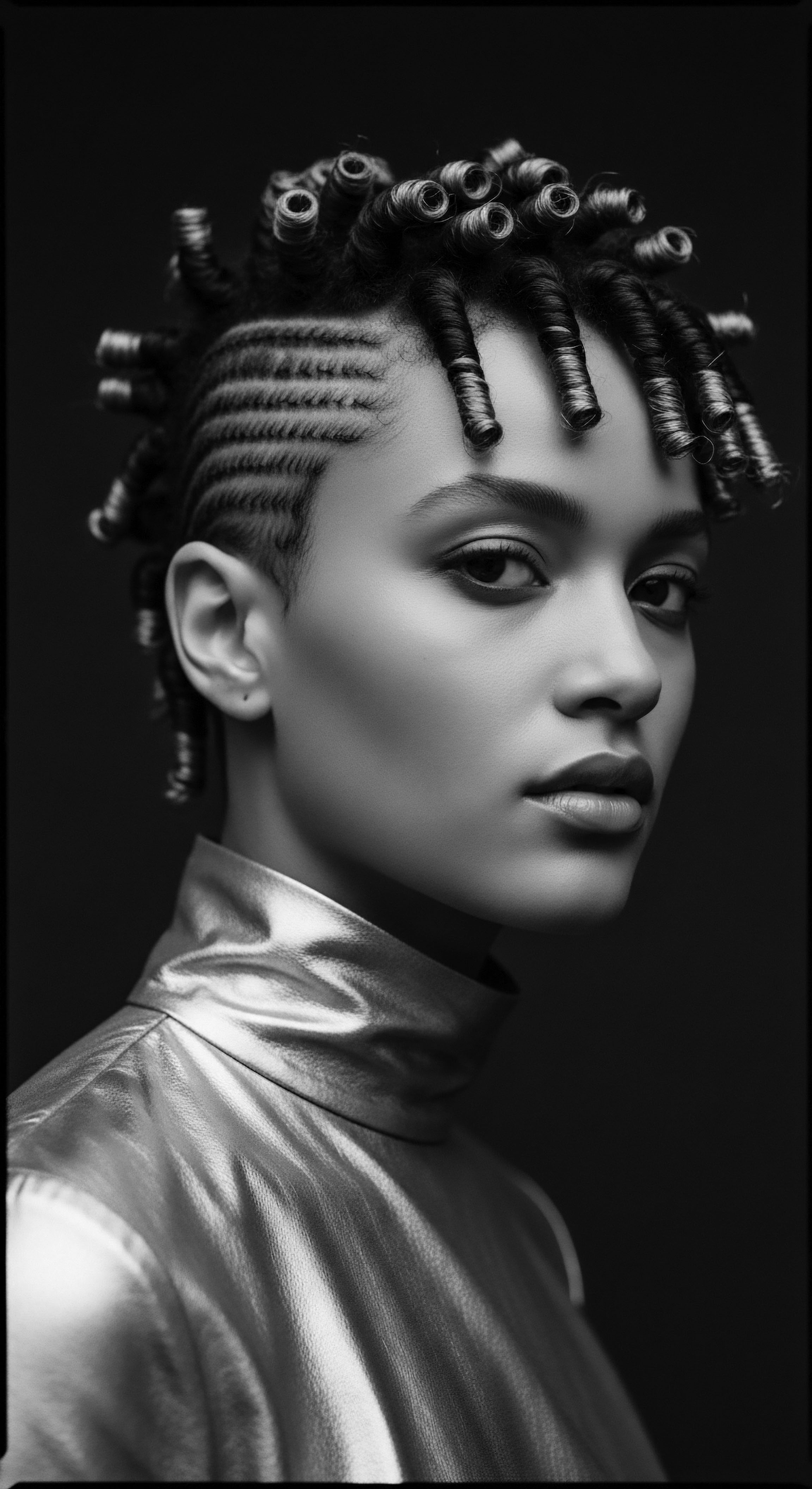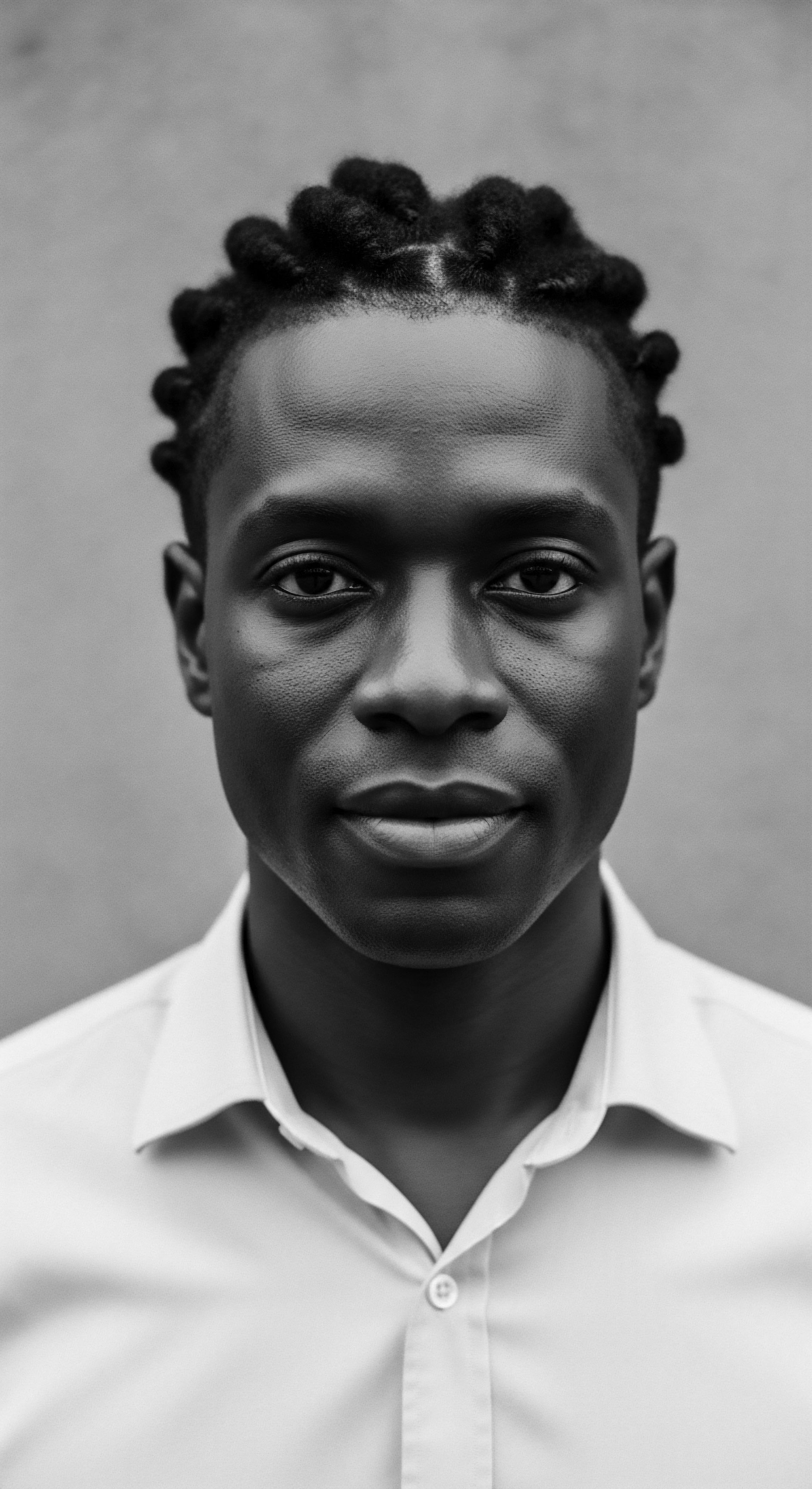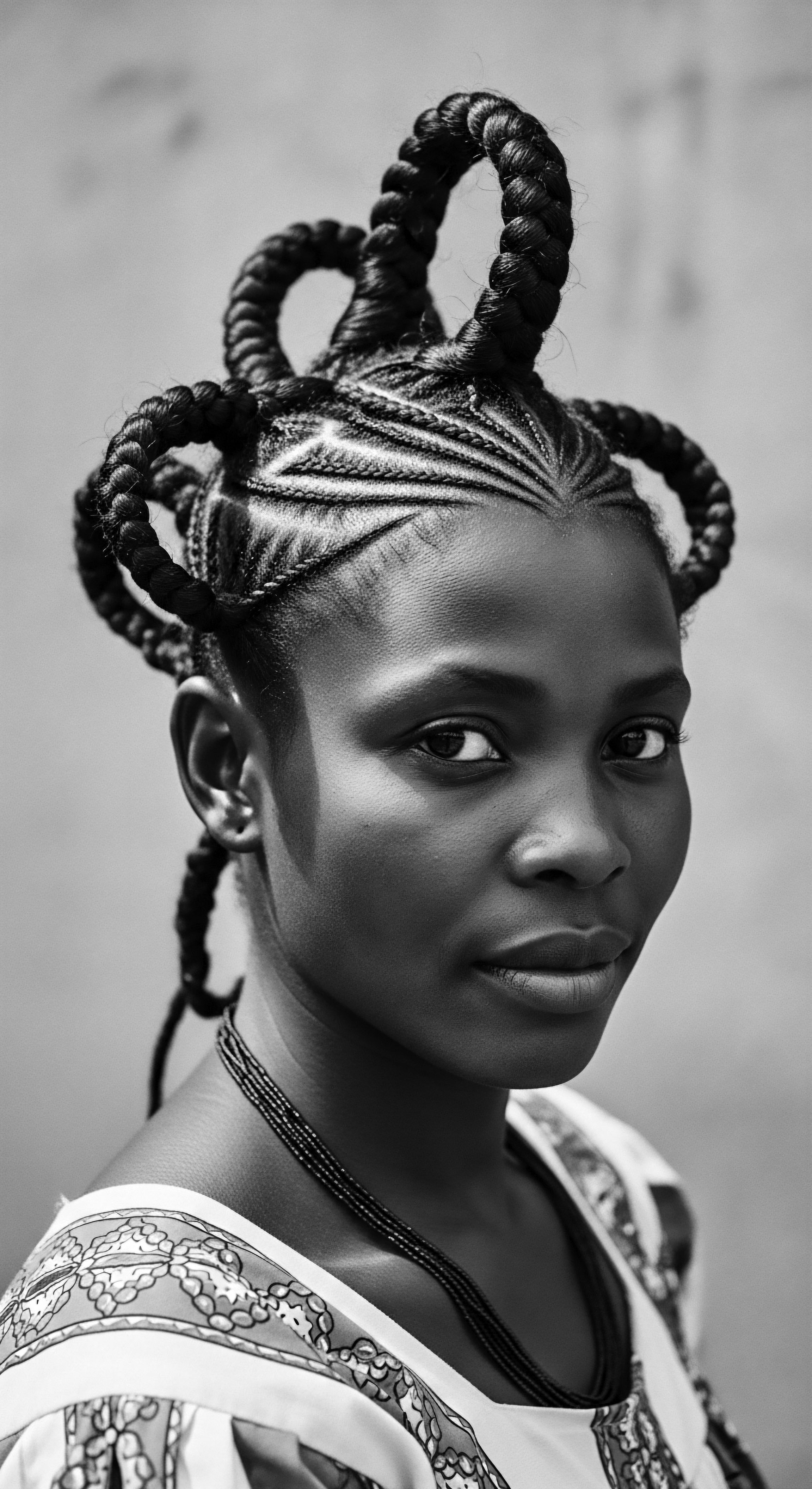
Fundamentals
The Natural Hair Movement, at its core, represents a profound reconnection to the inherent splendor and authentic texture of hair, particularly for individuals of Black and mixed-race heritage. This is not merely a styling preference; it stands as a deep declaration of cultural identity and a reclamation of ancestral wisdom. Its fundamental meaning extends beyond aesthetics, reaching into the very fibers of historical continuity and personal affirmation.
For many, it signifies a deliberate turning away from Eurocentric beauty ideals that historically marginalized and denigrated textured hair, instead celebrating the coiled, kinky, and wavy patterns that are genetically inherent. This movement invites a return to care practices that honor the natural state of the hair shaft, moving away from chemical alterations or excessive heat that have often been used to force hair into straightened forms.
From the earliest echoes of human existence, hair has held immense cultural and spiritual significance across various African societies. Before the transatlantic slave trade, the diverse styles of hair, often intricately braided or adorned, communicated a wealth of information about an individual’s social standing, marital status, age, tribal affiliation, and even spiritual beliefs. These practices were not just about appearance; they were integral to community life, serving as a visual language and a tangible link to one’s lineage.
The communal rituals of hair dressing, often taking hours, served as moments for intergenerational bonding, storytelling, and the transmission of cultural knowledge. The very act of caring for hair was a sacred practice, connecting individuals to their heritage and to the collective spirit of their people.
The historical trajectory of textured hair, particularly for those in the African diaspora, has been one marked by both profound beauty and persistent struggle. During the brutal era of enslavement, enslavers systematically sought to strip African people of their identities, and this often began with the forced shaving of hair. This act was a deliberate attempt to sever the spiritual and cultural connections that hair represented, aiming to dehumanize and control.
Despite these horrific efforts, the resilience of ancestral practices persisted. Hair became a covert canvas for resistance, a hidden archive of memory and survival.
The Natural Hair Movement stands as a vibrant resurgence, honoring the inherent beauty and historical fortitude embedded within every coil and curl of textured hair.
Consider the remarkable instances of enslaved African women in parts of the Americas, particularly within Maroon communities in Colombia and Suriname, who ingeniously used their hair as a medium for communication and survival. They would braid specific patterns into their hair that reportedly served as maps to escape routes, indicating paths through dense forests or waterways. Furthermore, some would hide precious seeds, such as rice grains, within their intricate braids, carrying a piece of their homeland and a means for sustenance into uncertain futures (Rose, 2020; Bogaard, 2022). This profound practice underscores the deeply rooted significance of textured hair as a repository of knowledge, a tool for liberation, and a testament to an enduring spirit.
This historical example is a powerful reminder that hair was, and remains, far more than a physical attribute; it is a living document of heritage, resilience, and the unyielding human desire for freedom and self-determination. The fundamental meaning of the Natural Hair Movement, therefore, is not a modern invention but a contemporary manifestation of this ancient, deeply ingrained understanding of hair’s intrinsic worth and its capacity to voice identity.

Intermediate
Moving to an intermediate understanding, the Natural Hair Movement extends its meaning beyond foundational principles, delving into how ancestral practices have been passed down, adapted, and reinterpreted across generations within the global Black and mixed-race diaspora. This section illuminates the practical applications of the movement within traditional and evolving hair care rituals, highlighting the continuity of heritage knowledge. The shift towards natural hair represents a conscious decision to align with the physiological characteristics of textured strands, understanding their unique needs for moisture, protection, and gentle handling. It signifies a profound respect for the hair’s natural inclinations, rather than attempting to force it into forms that demand constant manipulation or potentially damaging chemical treatments.
The transmission of hair care knowledge, from elder to youth, forms a crucial aspect of this heritage. In many families, the kitchen or porch became informal classrooms where generations learned the art of detangling, conditioning, and styling. These were not just lessons in technique; they were lessons in patience, self-care, and cultural pride. The Natural Hair Movement draws heavily from this oral tradition, seeking to formalize and share practices that might have been localized or fragmented due to historical displacements.
The movement has seen a resurgence in the use of ingredients that echo ancestral remedies, such as shea butter, coconut oil, aloe vera, and various herbal infusions. These natural elements, long utilized in African and diasporic communities for their nourishing properties, are now celebrated for their ability to promote healthy hair growth and maintain the structural integrity of textured hair.
The adoption of protective styles forms another vital component of the Natural Hair Movement, directly referencing long-standing heritage. Styles like braids, twists, and cornrows, which have been present in African cultures for millennia, serve multiple purposes. They minimize daily manipulation, retain moisture, and shield the hair from environmental stressors.
Their contemporary popularity within the Natural Hair Movement is a direct nod to their historical utility and cultural significance. These styles are not merely fashionable; they represent a functional beauty that speaks to a deep understanding of textured hair’s specific requirements, a wisdom passed down through generations.
The enduring legacy of traditional hair care practices finds renewed vitality within the Natural Hair Movement, demonstrating an unbroken chain of knowledge and self-respect.
The movement also encompasses a broader societal and psychological transformation. It represents a powerful counter-narrative to centuries of systemic discrimination and marginalization of textured hair. By choosing to wear natural hair, individuals are making a statement about self-acceptance, cultural pride, and a rejection of imposed beauty standards.
This choice, while personal, carries collective weight, contributing to a larger cultural shift that values and celebrates the diversity of Black and mixed-race hair. The journey of understanding the Natural Hair Movement at this intermediate level involves recognizing its dual nature ❉ a personal wellness practice and a collective act of cultural affirmation.
The language surrounding textured hair has also undergone a significant shift. Terms like “good hair” (often implying straighter textures) are being actively challenged and replaced with language that celebrates the full spectrum of hair types, from loosely wavy to tightly coiled. This linguistic reclamation is a subtle but powerful aspect of the movement, redefining beauty on its own terms and dismantling internalized biases. The emphasis is on hair health, versatility, and the unique characteristics of each individual’s strands, fostering an environment where all textures are acknowledged and revered.
The following table illustrates a few examples of how traditional practices have been adapted and reinterpreted within the contemporary Natural Hair Movement, underscoring the continuous evolution of heritage.
| Ancestral Practice/Ingredient Shea Butter |
| Traditional Application (Heritage Context) Used as a deep moisturizer and protective balm in West African communities. |
| Contemporary Application (Natural Hair Movement) Applied as a sealant, deep conditioner, or styling cream for moisture retention and curl definition. |
| Ancestral Practice/Ingredient Hair Braiding/Cornrows |
| Traditional Application (Heritage Context) Communicated social status, tribal identity, and even escape routes during enslavement. |
| Contemporary Application (Natural Hair Movement) Employed as a protective style to minimize manipulation, retain length, and express cultural identity. |
| Ancestral Practice/Ingredient Herbal Rinses (e.g. Chebe Powder) |
| Traditional Application (Heritage Context) Used by Chadian women for hair strength and length retention, often infused with oils. |
| Contemporary Application (Natural Hair Movement) Incorporated into hair masks, pre-poo treatments, or rinses for scalp health and strand fortification. |
| Ancestral Practice/Ingredient Communal Hair Styling |
| Traditional Application (Heritage Context) A social ritual for bonding, storytelling, and intergenerational knowledge transfer. |
| Contemporary Application (Natural Hair Movement) Informal gatherings, online communities, and salons serve as spaces for shared learning and support. |
| Ancestral Practice/Ingredient This table highlights the unbroken lineage of textured hair care, where ancient wisdom finds new expressions in the modern Natural Hair Movement, reinforcing a deep connection to heritage. |
The movement’s influence extends into product development, with a proliferation of brands dedicated to natural hair care. These products often feature ingredients that have long been part of traditional hair care, reformulated for contemporary use. This commercial aspect, while sometimes debated, nonetheless contributes to the accessibility of natural hair care, making it easier for individuals to maintain their chosen hair journey while honoring ancestral ingredients.
Ultimately, the intermediate understanding of the Natural Hair Movement reveals a dynamic interplay between historical precedent and contemporary adaptation. It is a testament to the enduring spirit of textured hair heritage, a continuous conversation between past and present, expressed through intentional care and profound self-regard. The movement serves as a living archive, demonstrating how practices rooted in antiquity can be re-imagined and celebrated in the present, fostering a deeper connection to one’s lineage and a greater appreciation for the beauty of authentic hair.

Academic
At an advanced academic level, the Natural Hair Movement is understood as a complex socio-cultural phenomenon, a profound act of self-determination, and a biological affirmation, specifically within the intricate contexts of textured hair, Black hair, and mixed-race hair heritage. Its academic explication requires a multidisciplinary lens, drawing from anthropology, history, sociology, ethnobotany, and trichology to delineate its full significance. This is not merely a trend; it is a critical re-evaluation of beauty paradigms, a decolonization of self-perception, and a scientific validation of the inherent structural and physiological requirements of diverse hair patterns. The movement’s true import lies in its ability to challenge pervasive systemic biases, providing a counter-hegemonic discourse against centuries of aesthetic oppression.

Historical and Anthropological Delineation
From an anthropological standpoint, the Natural Hair Movement represents a conscious revival and re-interpretation of hair as a primary cultural signifier. In many pre-colonial African societies, hair styling was a sophisticated form of non-verbal communication, denoting intricate social hierarchies, spiritual affiliations, marital eligibility, and even tribal identities. The meticulous crafting of elaborate coiffures was often performed by specialized practitioners, underscoring the communal and ritualistic aspects of hair care. The imposition of European beauty standards during colonialism and slavery systematically dismantled these practices, reducing textured hair to a symbol of “otherness” or “unruliness.” The Natural Hair Movement, therefore, functions as a powerful act of cultural retrieval, a deliberate unearthing of ancestral aesthetics and their underlying philosophical tenets.
It seeks to restore the semiotic richness of textured hair, transforming it from a site of subjugation into a symbol of pride and autonomy. This restoration is not a static replication of the past but a dynamic re-engagement with historical forms, allowing for contemporary expression while honoring foundational heritage.
The historical trajectory of the Natural Hair Movement reveals a cyclical pattern of resistance and resurgence. While its contemporary iteration gained prominence in the early 21st century, earlier waves of natural hair affirmation, such as the Afro movement of the 1960s and 70s, served as potent symbols of Black liberation and identity. The current movement distinguishes itself through its global reach, digital interconnectedness, and a more nuanced understanding of the vast spectrum of textured hair types.
It recognizes the diverse biological characteristics of hair, from loosely wavy (Type 2) to tightly coiled (Type 4C), acknowledging that each pattern possesses unique structural properties and care requirements. This biological specificity informs the movement’s emphasis on moisture retention, gentle manipulation, and the avoidance of harsh chemicals that disrupt the hair’s natural protein bonds and lipid layers.

Biological and Trichological Interpretation
From a trichological perspective, the Natural Hair Movement provides a scientific validation for care practices that respect the unique helical structure of textured hair. The elliptical cross-section of highly coiled hair, coupled with its lower density of cuticle layers and fewer disulfide bonds compared to straighter hair, renders it more susceptible to dryness, breakage, and tangling. The natural hair regimen, emphasizing co-washing, deep conditioning, and protective styling, directly addresses these biological vulnerabilities.
The movement’s insistence on minimizing heat application and avoiding chemical relaxers mitigates damage to the hair’s keratin structure, preserving its natural elasticity and strength. This scientific understanding is not separate from heritage; rather, it often provides modern explanations for the efficacy of traditional practices, such as the use of natural oils and butters for sealing moisture or the protective benefits of braids and twists.
The Natural Hair Movement academically clarifies the intricate interplay between biological hair characteristics and their profound socio-cultural significance, asserting that ancestral care practices often align with contemporary trichological understanding.
Consider the meticulous research into the biomechanics of hair fibers, which reveals how the tight coiling of certain hair types creates points of stress along the strand, making them more prone to fracture. The Natural Hair Movement’s advocacy for low-manipulation styles and specific moisturizing techniques directly counters these inherent vulnerabilities. This scientific lens allows for a deeper appreciation of ancestral wisdom, demonstrating how traditional methods of care were often intuitively aligned with the biological needs of textured hair, even without the aid of modern microscopy or chemical analysis. The integration of scientific understanding with cultural practices forms a robust framework for comprehending the movement’s comprehensive approach to hair wellness.

Sociological and Psychological Implications
Sociologically, the Natural Hair Movement represents a powerful act of resistance against prevailing beauty standards and systemic discrimination. The historical context of hair texture being weaponized to create caste systems during slavery, where lighter skin and straighter hair often conferred perceived privileges, continues to cast a long shadow. Hair discrimination, codified in some regions through discriminatory policies, has historically limited opportunities in education and employment for individuals with natural, textured hair.
The movement, therefore, functions as a civil rights issue, advocating for legislative protections (such as the CROWN Act in the United States) that prohibit discrimination based on hair texture or protective styles. This collective advocacy underscores the movement’s role in shaping future societal norms and fostering a more inclusive definition of professional and aesthetic acceptability.
Psychologically, the Natural Hair Movement facilitates a process of self-acceptance and identity affirmation. For many, the journey to natural hair involves confronting internalized negative perceptions and embracing a previously marginalized aspect of their identity. This process can be deeply transformative, fostering increased self-esteem and a stronger connection to one’s heritage.
The communal aspect of the movement, often facilitated by online platforms and social gatherings, provides vital support networks, allowing individuals to share experiences, exchange knowledge, and celebrate their collective journey. This shared experience cultivates a sense of belonging and reinforces the validity of diverse beauty expressions.
The following list outlines key aspects of the Natural Hair Movement’s academic significance, highlighting its multifaceted nature:
- Decolonization of Aesthetics ❉ Challenges and dismantles Eurocentric beauty standards that historically marginalized textured hair, promoting a re-centering of Afrocentric aesthetics.
- Cultural Reclamation ❉ Revives and reinterprets ancestral hair care practices and styling traditions, linking contemporary expressions to a rich historical lineage.
- Biological Affirmation ❉ Validates and scientifically explains the unique structural and physiological needs of textured hair, advocating for care regimens that honor its natural state.
- Socio-Political Activism ❉ Drives legislative efforts to combat hair discrimination, advocating for policies that protect individuals’ right to wear their natural hair in all settings.
- Identity Formation ❉ Provides a powerful avenue for self-acceptance, cultural pride, and the development of a positive racial identity, fostering psychological well-being.
- Economic Empowerment ❉ Stimulates the growth of a specialized industry focused on natural hair products and services, creating new entrepreneurial opportunities within Black and mixed-race communities.
The academic understanding of the Natural Hair Movement is thus a compound and deeply insightful explication of its full significance. It reveals a dynamic process of historical remembrance, scientific discovery, and social transformation. The movement is not merely about hair; it is about identity, autonomy, and the ongoing quest for justice and recognition.
It is a living testament to the power of heritage to shape present realities and future possibilities, a continuous dialogue between the echoes of the past and the aspirations of tomorrow. This advanced perspective offers maximum insight into the movement’s enduring impact on individual lives and broader societal structures, underscoring its enduring legacy as a profound meditation on textured hair, its heritage, and its care.

Reflection on the Heritage of Natural Hair Movement
As we contemplate the profound currents of the Natural Hair Movement, it becomes clear that its true spirit resides within the very Soul of a Strand. Each coil, every wave, carries within it the whisper of generations, a living archive of resilience, wisdom, and beauty. This movement is more than a return to an unadorned state; it is a spiritual homecoming, a conscious decision to honor the ancestral practices that sustained communities through epochs of challenge and triumph. It is a testament to the enduring power of heritage, demonstrating how a connection to one’s roots can provide both grounding and wings.
The journey of textured hair, from ancient ceremonial adornments to symbols of covert resistance during enslavement, and now to a vibrant expression of self-love and cultural pride, illustrates an unbroken lineage. This reflection invites us to perceive hair not just as a physical attribute, but as a sacred extension of self, a tangible link to the past, and a canvas for future expressions of identity. The care rituals, the choice of natural ingredients, the embrace of protective styles—all these elements are not modern inventions but echoes from the source, re-imagined for the contemporary world.
The Natural Hair Movement stands as a vibrant testament to the fact that beauty is not monolithic; it is a spectrum as diverse and rich as the human experience itself. It is a continuous narrative, penned by those who wear their heritage with pride, celebrating the unique splendor of textured hair as a profound gift, passed down through the ages.

References
- Bogaard, C. (2022). African Slaves Used Braids to Communicate Escape Routes in Colombia. Ancient Origins.
- Byrd, A. D. & Tharps, L. D. (2014). Hair Story ❉ Untangling the Roots of Black Hair in America. St. Martin’s Griffin.
- Gordon, E. E. (2018). The Natural Hair Handbook ❉ A Guide to Natural Hair Care and Styling. CreateSpace Independent Publishing Platform.
- Hooks, B. (1992). Black Looks ❉ Race and Representation. South End Press.
- Khumalo, M. (2019). Hair ❉ A Book of Braiding and Styling. Jacana Media.
- Patton, T. O. (2006). Pushing the Boundaries ❉ Black Women and the Quest for Natural Hair. Palgrave Macmillan.
- Rose, S. (2020). How Enslaved Africans Braided Rice Seeds Into Their Hair & Changed the World. BlackPast.org.
- Simmons, L. (2018). The Hair Care Revolution ❉ Natural Hair Care for Black Women. Self-Published.
- Thompson, S. (2009). Black Women and the Natural Hair Movement ❉ A Social and Cultural Analysis. University of California Press.
- Walker, A. (2004). The Black Hair Book ❉ A Complete Guide to Healthy Hair for African American Women. Broadway Books.
